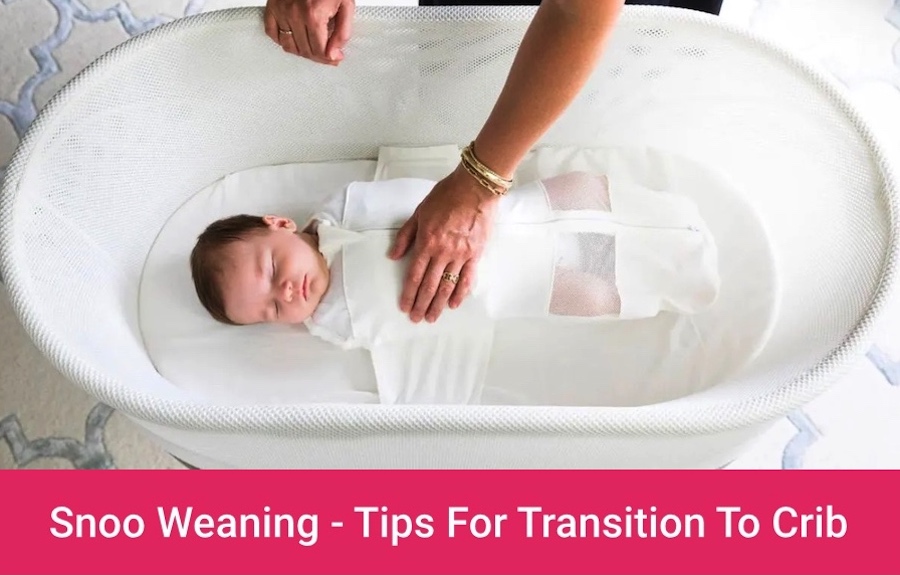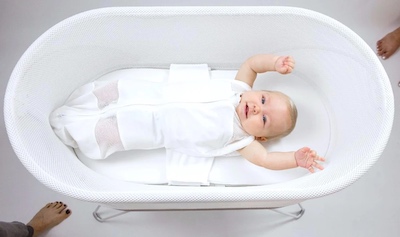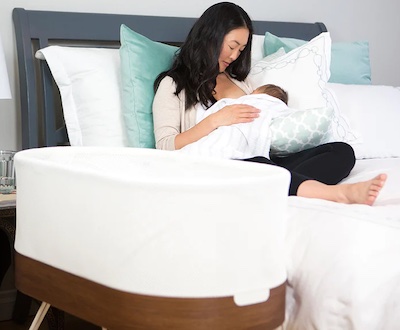
Article by Jessica Pierce – Registered Nurse & Nationally Registered Paramedic
The Snoo.
Love it or hate it – seriously, who would hate having Snoo though? – you unfortunately can’t use it forever.
Eventually, your sweet lil baby will grow out of their amazing first bassinet and need to transition to a crib for sleep.
Scared or worried about how this big move will go, or what will happen if you try to make the switch too early? Fear not – in this article, I’m going to unpack everything you need to know about how to transition your little one from Snoo to crib.
Keep reading to discover all the best tips, tricks, and life hacks to make the transition easy and peaceful both for you and your baby.
This article is not a substitute for medical advice or consultation.
When To Transition From Snoo To Crib
“When to stop using Snoo” is a very commonly searched question – and I’ve rounded up the answers for you here! There are 3 things to consider if you’re wondering when to stop using Snoo: baby’s age, weight and milestones.

Here’s how to know that your baby is ready to transition from the Snoo to a crib:
1. They’re Six Months Old
The Snoo crib is designed for infants up to six months of age. Dr. Harvey Karp, the inventor of the Snoo, lets us know that once babies reach 5 or 6 months old, they have generally gotten used to the still, quiet sleep space of the outside world.
Essentially, the Snoo’s main job is to make the transition from Mama’s tummy to the fourth trimester a little bit easier. Once that’s done, baby can get good sleep in a crib just as well as the Snoo.
2. They’ve Started To Roll Or Crawl
It’s recommended to transition babies to a crib once they can roll from back to front, or are able to get up on hands and knees. These big movers will benefit from having a bit more free range at night, and it’s important for baby’s arms to be free so they don’t get stuck in an unsafe sleeping position.
3. They Weigh More Than 33 Pounds
If your baby hits a big ‘ole growth spurt before they seem ready to sleep in a crib, there’s not necessarily a need to panic!
The Snoo is designed to safely hold a child up to the size of a 9-month-old in the ninety-fifth percentile. Even if baby’s toes touch the bottom of the Snoo, you might not have to ditch it just yet.
The pediatrician who designed the Snoo bassinet reminds us that babies sleep with their legs in somewhat of a frog position – and that this is a normal part of development. Baby’s weight and movement abilities are far more important than their length in crib sizing.

What Age Do Babies Wean Off Snoo?
The Snoo bassinet is designed for babies up to 6 months old, or babies who can roll over and get on their hands and knees. Either of these times is a good point to start weaning from Snoo to crib.
| PRO TIP: Snoo is the most expensive bassinet – but don’t worry if it’s out of your budget! Here are amazing Snoo alternatives and knockoffs that also have smart features and help to soothe fussy infants, but won’t cost you an arm and a leg! |
How To Transition Baby From Snoo To Crib – 5 Tips
Here are several of the best tried and true tips from real parents and baby sleep experts on how to wean your baby from their Snoo.
1. Do The Hokey Pokey
A couple weeks before you want your baby to move to the crib, let them sleep with one arm out of the Snoo swaddle for a few nights and see how they do. If they are frequently startling themselves awake by having one arm out, just put it back in the Snoo sack for another night or two and try again.
This is one of the most commonly recommended Snoo weaning steps. Always ensure the bed’s safety clips are properly engaged to prevent baby from wiggling out of their sleep sack, and/or getting stuck in an unsafe sleeping position.

2. Half In, Half Out
The next step is to swaddle with both your child’s arms free. This should take another few nights for baby to get used to, but the snug embrace of the sleepsack along with the constant rumbling sound should help them fall asleep again if baby fusses.
If their arms jerk about while they sleep and wake them up, you can always go back to one or both arms swaddled until night sleeping gets a bit better.
Once your baby sleeps well in their new room or bed, you can use a Sleepea sack, which is basically the sleep sack you’ve already been using but without the Snoo sack’s wing loops. This can be especially helpful as your child transitions out of the Snoo bassinet.
3. Use The Weaning Mode
Snoo’s makers recommend parents turn on the weaning mode of the Snoo bassinet about a week before you move your baby to their crib. As part of the weaning feature, the Snoo responds to soothe baby with sound but no motion, or minimal motion that subsides once they go back to sleep1.
After using the weaning feature to wean motion, it’s a good time to swap your Snoo out for a conventional crib. There’s no need to wean off of the white noise, however – especially if you have a standalone sound machine. White noise can help babies sleep well even into the toddler years.
Some parents prefer to try the cold turkey method, and simply switch their baby over to a crib all at once without using the weaning mode. This actually works for some babies – but remember, every baby is different. What works for one child may or may not work for another!

4. Make The Crib Familiar
Start getting your baby used to their new sleep space by spending some awake time playing in their next bed2. If baby cries, comfort them and simply spend some time together in the room where they will be sleeping.
Many experts recommend starting crib time during night sleep, as baby is more tired and might be able to complete the transition sooner. But you can also try using the crib just for the first nap during the day and gradually add more naps in the crib, instead of Snoo3.
Play white noise in the new room – bonus points if it’s the same white noise they’ve already been going to sleep to! The mobile application that accompanies the Snoo has the same white noise tracks available as the crib itself does, making this even easier.
5. Perfect Your Bedtime Routine
Maintaining good sleep patterns is heavily dependent on helping your baby understand when it’s time to sleep. Swaddling, singing, reading bedtime stories, and other calm and soothing activities prep your little one for good nighttime sleep.
When transitioning baby to their own room or their own crib, invest in a white noise machine to put right next to baby’s crib in the new room.
Or if they are still sleeping in the same room as Mom or Dad, the app that comes with a Snoo can play the same white noise they’re already used to from the Snoo, eliminating the need to purchase a new white noise machine.

Do Babies Become Dependent On Snoo?
In general, most parents find that once their baby has naturally outgrown their need for the sounds and motions of the Snoo, transitioning from Snoo to crib actually isn’t that bad! In fact, some babies are even able to go to a new crib cold turkey.
Dr. Karp explains that babies don’t actually develop a dependence on sound and motion to sleep after birth – they’re already born with it. Think about it: what’s happening all that time baby is growing in the womb?
Baby is born used to being rocked by each of Mom’s breaths, steps, laughs, and hiccups…and hears everything you hear as well (just a little muffled, of course.) When they come into the world and are placed in a still, quiet environment to sleep, this can feel really abnormal to them, making sleep harder to get to.
So technically, the Snoo was designed to help wean a newborn baby from the womb rather than serve as a crutch. By introducing stimuli that your little one has been familiar with before birth, the Snoo mimics a womblike environment that can make sleeping easier while they adjust to life in the big world outside.

Do Babies Have A Hard Time Transitioning From Snoo?
Many parents wonder if their baby will have a harder time transitioning from the Snoo to the crib than they would from a standard bassinet. This is a valid question!
In general, most babies actually don’t have that much trouble with the transition to the crib. The first night or two may be a bit rough, but if you move your baby at the right time and after the right developmental milestones, the Snoo has hopefully helped your baby learn to soothe him or her self.
The makers of Snoo hold that once a baby is old enough to outgrow their Snoo, they’ll also have outgrown the dependence on sound and motion that they were born with and thus will no longer need the features of the Snoo.
Some babies may be different, but many pediatricians will back this up.
This means you don’t have to worry that transition from Snoo to crib is going to be a nightmare! It’s not any harder than from other bassinets to crib.

Transitioning From Snoo To Crib Too Early
The good news is, even if your baby isn’t quite ready for the Snoo to crib transition when you start weaning, it’s very easy to recover from and shouldn’t cause any extra problems down the road.
Some parents who tried to start weaning their baby from the Snoo between the ages of 3 to 4 months noticed that the transition coincided with the dreaded four-month sleep regression that threw everything off. That’s why the makers of Snoo recommend you wait to start weaning until your baby is about 6 months old.
If this happens, simply go back to the Snoo settings your baby is used to for a week or so before trying again – no harm done!

I hope this article provided you with some practical tips, tricks, and life hacks on how to get your new baby happily sleeping through the next phase of their bedtime journey. Remember to be patient with both them and yourself – after all, this may be a learning experience for you both!
Keep coming back to this article for a knowledge brush-up with future Snoo sleepers, or some guidance and support as you navigate this tricky transition. Here’s to a good night’s sleep – for all of us.
Article By Jessica Pierce, RN
Jessica Pierce is Registered Nurse, Nationally Registered Paramedic, writer, and contemporary dance artist based in Tulsa, Oklahoma. She holds two undergraduate degrees from Oral Roberts University – a Bachelor’s of Science in Nursing (2018) and a Bachelor’s of Art in Dance Performance (2019).
The purpose of this article is informative. It’s not a substitute for professional medical advice or medical care. Remember: safety first! Consult your doctor/pediatrician in case of any doubts. The author of this article does not accept any responsibility for any liability, loss or risk, personal or otherwise, incurred as a consequence, directly or indirectly, from any information or advice contained here.
Resources:
https://happiestbaby.com.au/
https://www.babysleepsite.com/
https://thesleepyheadcoach.com/

